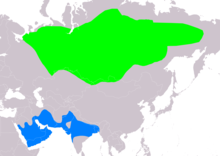Taigazilpzalp
| Taigazilpzalp | ||||||||||||
|---|---|---|---|---|---|---|---|---|---|---|---|---|

Taigazilpzalp ( Phylloscopus tristis ) |
||||||||||||
| Systematics | ||||||||||||
|
||||||||||||
| Scientific name | ||||||||||||
| Phylloscopus tristis | ||||||||||||
| Blyth , 1843 |
The Taigazilpzalp ( Phylloscopus tristis ), also Siberian Chiffchaff , Siberian Chiffchaff or Siberian Chiffchaff called, is a bird art from the family of warbler-like (Phylloscopidae). The species is still classified by many authors as a subspecies of the chiffchaff . In Central Europe, the species is a rare wanderer, but it is possibly more often overlooked, as it is very difficult to determine in field observations.
description
The Taigazilpzalp reaches a body length of ten to eleven centimeters. On average, it weighs 7.4 grams. Shape and plumage hardly differ from the (western) chiffchaff, at best the light over-eye stripe is often a little longer than this. The only sure distinguishing feature is therefore the singing and the calls. The singing of the Taigazilpzalp only vaguely resembles that of the Chiffchaff, is much softer, less regular but more melodic. Correspondingly, the song of the other species is not recognized as belonging to the species and remains unanswered. The calls are comparatively thin and monosyllabic. Instead of the typical “hü-it” of the chiffchaff (or regionally also “swie-u”), the characteristic call of the taiga bilpzalp is just a simple “hie”.
Spread and train
The Taigazilpzalp is a breeding bird on the Kanin Peninsula and in the Pechora Basin in the north and northeast of the European part of Russia. In an easterly direction it occurs from there through Siberia to the middle reaches of the Kolyma . In Central Asia there are some islands in Sinkian, the Pamir, Hindu Kush and the northwest of the Himalayas. Its habitat is the coniferous forest taiga. The highest population densities are found in alluvial forests with high levels of willow.
The Taigazilpzalp is a long-distance migrant. The main wintering areas are in India and Nepal as well as in Iran and the Arabian Peninsula.
literature
- Hans-Günther Bauer, Einhard Bezzel , Wolfgang Fiedler (eds.): The compendium of birds in Central Europe: Everything about biology, endangerment and protection. Volume 2: Passeriformes - passerine birds. Aula-Verlag Wiebelsheim, Wiesbaden 2005, ISBN 3-89104-648-0 .
- Urs N. Glutz von Blotzheim & Kurt M. Bauer: Handbook of the birds of Central Europe . Passeriformes (3rd part): Sylviidae, licensed eBook edition. Ed .: Urs N. Glutz von Blotzheim. tape 12 . Aula-Verlag, 2001, ISBN 3-923527-00-4 .
- J. del Hoyo & N. Collar: Siberian Chiffchaff ( Phylloscopus tristis ) . In: J. del Hoyo, A. Elliott, J. Sargatal, DA Christie & E. de Juana, E. (Eds.): Handbook of the Birds of the World Alive . Lynx Edicions, Barcelona 2018 ( hbw.com [accessed September 10, 2018]).
Web links
- Singing and shouting at xeno-canto
- Phylloscopus tristis inthe IUCN Red List of Threatened Species 2018.1. Listed by: BirdLife International, 2016. Retrieved September 10, 2018.
